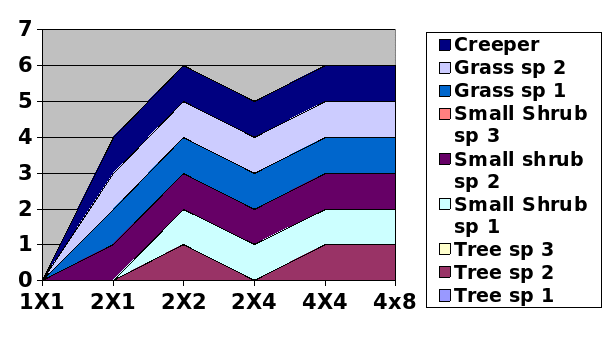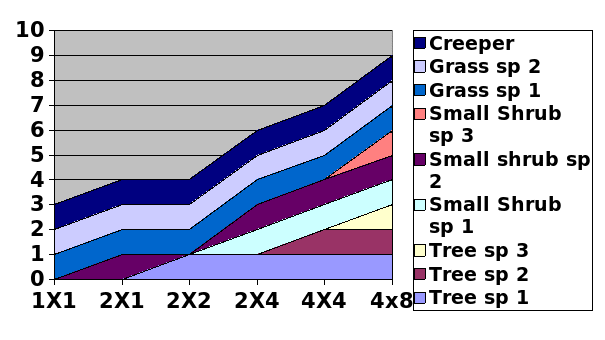Introduction
An ecosystem can be defined as the collection of living and nonliving objects in a specific area. The study of ecosystems is thus considered important because it helps us to gain an understanding of some of the useful services that enhance our well being that is provided by the environment (IUCN 5). Without this understanding, we can damage the environment following which the degradation would have a significant adverse impact on our well being (IUCN 5). This study is supposed to help in improving decision making within the location studied.
Methods
The location chosen for this study was a small area within a park. The park is located within a city and is frequented by many visitors daily for a variety of reasons. This location was selected first and foremost because it was easily accessible and did not require the researcher to spend too much money on the study. The area of the park selected for study was a grassy area with a few trees and shrubs.
To perform the study the researcher selected a random square quadrat measuring 1m by 1m. The quadrat was marked using pegs to indicate the boundaries. After identifying and marking the quadrat, the researcher noted down each species that was within the quadrat. After this was completed the size of the quadrat was increased to 1m by 2m and the recording was repeated. The quadrat was again increased to 2m by 2m and recording was done. Then 2m by 4m, 4m by 4m and finally 8m by 4m. This exercise was mainly carried out during the afternoon between 2 P.M. and 4 P.M. on weekdays. Upon completion of studying the first quadrat, the exercise was again repeated in another quadrat within the park.
Results
Following the completion of the exercise the data collected was tabulated for easier assessment (See Appendix B). Following analysis of the data on species and the density as the area evaluated increases it is possible to assume that the richness of species increases as the area studied increases (See Appendix C and D).
Biotic Components
Upon observation of the data from each quadrat, it became apparent that the number of species grew with the size of the quadrat. This is best observed by looking at the data in a tabulated form.
Interactions between Biotic and Abiotic Components
Upon observation of the data from the study, in the first quadrat, it was observed that the biotic matter was mainly composed of various species of plants. However, there were also a few species of ants, other insects, slugs present in the ecosystem. Alongside these biotic components, there were several abiotic components such as soil, a few rocks, and light.
It has been determined that biotic factors are living organisms and within an ecosystem, there is the interaction between both the living and non-living organisms (Enger 304). In the completion of this study, it is necessary to use the data to observe the interaction between various factors within the ecosystem. For example, to provide information on how abiotic factors affect the living organisms in the environment.
The first example of the interaction between abiotic factors and the living organisms is seen in the example of the slug hidden under a rock. Slugs are typically nocturnal feeders (Vessel and Hong 15). The main sign that indicates their presence is evidence of slime left as they glide along the ground. These organisms are very sensitive to temperature and can only come out to feed during twilight hours when the sun has gone down. During these hours these organisms find their way to their favorite plants to feed.
Upon observation of the ground in the area of study it was possible to note that the ants in the area had formed tunnels below the surface where they would store food, reproduce and perform other activities. It has been reported that in some ecosystems ants are responsible for seed dispersal (Gorb and Gorb 1). Based on research it has been known since ancient times that ants can be actors in the dispersal of seeds produced by plants.
Based on this notion the plants use the ants to sow their seeds in various locations within an ecosystem. This comes in light of the ant’s nature of carrying food from the source to their habitations (Gorb and Gorb 3). This also provides an example of how living organisms can affect the abiotic environment over time. This because the abiotic features such as soil will be used to host a new plant over time due to the introduction of seed brought by the living organisms. In addition to that ants also affect the soil by aerating it and allowing for increased water flow due to their burrowing activity.
Energy Flow in the Ecosystem
It has been observed that the metabolic activity of an ecosystem can best be understood by observing the individual metabolic activity of the individual organisms that make up the ecosystem (Krebs 341). In the hierarchy of feeding relationships, the primary producers are at the first trophic level (Starr, Evers, and Starr 711).
Similarly in the ecosystem studied the primary producer appears to be the grass that covers the park floor and the leaves of the various plants in the park. Just as in the above example the primary consumer in this ecosystem is the insects that are in abundance in the park. These insects include ants, beetles, and insect larvae among others. The next trophic level about the food chain is the secondary consumer.
Within the selected ecosystem these include organisms that feed on the insects mentioned in the previous paragraph. Some examples of secondary consumers in this ecosystem include birds and spiders. The birds fly around the park and eat berries from plants as well as insects they can catch. Similarly, the spiders have webs where they trap various insects for food.
Though it was not possible to observe any of the tertiary consumers in the park due to the brief time spent in observation it is assumed that they do exist. It has been observed that tertiary consumers are usually larger carnivores that feed on the smaller species living within an ecosystem (Toole and Toole 102). For example, within the studied ecosystem, likely, the presence of birds such as hawks would then suggest evidence of a tertiary consumer in the park. These birds would consume the smaller birds and even small mammals such as mice within the park. The food chain within the park is shown in the Appendix (see Appendix A).
Chemical Cycling
The process of chemical cycling is also sometimes referred to as nutrient cycling and involves the transformation of nutrients from one chemical form to another (Reshi and Tyub 177). In this process of conversion of chemicals decomposition is a very essential element. In the case of the ecosystem studied in this report, it was possible to observe dead leaves especially in places where the tree cover was abundant. In addition to this, there was evidence of occasional bird droppings on rocks and even on the benches.
On close observation of the dead leaves, it was possible to see that fresh leaves on the surface were dry while those below the surface were warm and moist supposedly owing to the beginning of decomposition. This condition was evident in observing small branches that had fallen from trees as some were dry and others had become moist and softened. It has been suggested that the main actors in decomposition are microbial organisms whose main function is the defragmentation of matter (Reshi and Tyub 107).
Conclusion
This report was carried out based on a need to evaluate an ecosystem. The report involved an analysis of the environment based on observation of the species within that ecosystem. Upon observation of the data analyzed it was clear that as the area analyzed expanded so too did the variety of species found. In addition to an increased variety of species, the variety of actors in the ecosystem also increased. The report allowed the researcher a brief glimpse into various aspects related to the ecosystem such as the producers and consumers within the environment.
Works Cited
Enger, Eldon. Concepts in Biology. Printed in the Philippines: McGraw-Hill Publishers. 207. Print.
Gorb, Elena, and Stanislav Gorb. Seed dispersal by Ants in a Deciduous Forest Ecosystem. The Netherlands: Kluwer Academic Publishers. 2003. Print.
Krebs, Charles J. The ecological World View. Collingwood, Australia: CSIRO Publishing. 2008. Print.
IUCN – The World Conservation Union, Nature Conservancy (US), World Bank. How much is assessing an Ecosystem Worth? Assessing the Economic Value of Conservation. Washington: The International Bank for Reconstruction and development. 2005. Print.
Reshi, Zafar, and Sumira Tyub. Detritus and Decomposition in Ecosystems. New Delhi: New India Publishing Agency. 2007. Print.
Starr, Cecie, Christine A. Evers, and Lisa Starr. Biology: Concepts and Applications. Belmont, CA: Brooks/Cole. 2010. Print.
Toole, Glen, and Susan Toole. Essential AS Biology for OCR. Cheltenham, UK: Nelson Thornes Ltd. 2004. Print.
The vessel, Mathew F. and Herbert H. Wong. Natural History of Vacant Lots. Berkeley: University of California Press. 1987. Print.
Appendix
Appendix A: Study food chart

Appendix B: Quadrats
Appendix C: AREA 1 Graph indicating the distribution of species

Appendix D: AREA 2 Graph indicating the distribution of species
